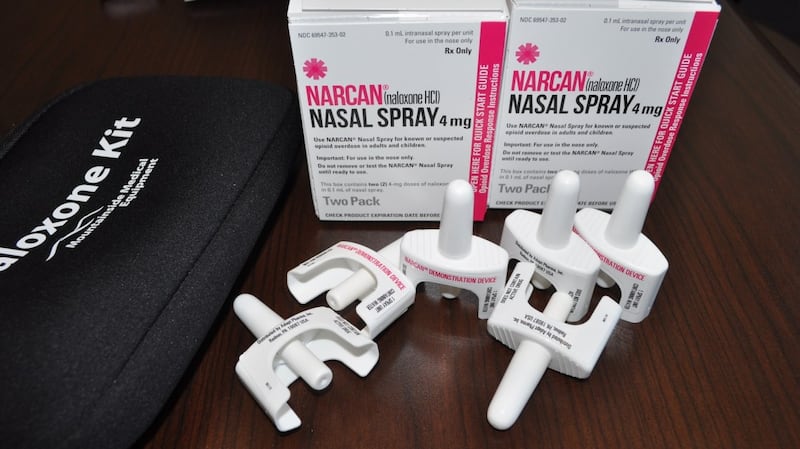Ten minutes passed before the emergency services arrived. Two doses of medication were needed to revive her.
“I had no pulse. I had nothing. I was not breathing until that second dose of Narcan,” said “Alicia”, who did not give her real name for fear her employer would see it. “I would not be here but for Narcan.”
Narcan, made by Irish firm Adapt Pharma, is becoming an increasingly familiar name in the US.
Some 640,000 doses of its nasal spray, worth some $30 million*, were shipped there in the 11 months to the end of last year. Coroners’ offices, rehabilitation workers and street activists say it has saved many lives.
Alicia is the mother of an 11-year-old son and a recovering drug addict.
Her story is part of one of the most serious public health emergencies in recent US history, with tens of thousands of people dying from opioid overdoses.
The problem is driven by a highly potent, and often deadly, drug called fentanyl. The synthetic opioid is 50 times more powerful than heroin.
It is a prescription drug, originally designed to ease the suffering of stage four cancer patients and serious burn victims. It was also prescribed to those suffering from much lesser pain and some leaked on to the street.
Police says most of the fentanyl on the streets is now produced illegally in laboratories, largely in Mexico. Initially it was mixed with heroin, but increasingly doses of pure fentanyl are making their way into the bloodstreams of addicts.
About 23,000 died from fentanyl and heroin overdoses in the US in 2015.
Three years earlier, fentanyl was not even classified separately by health agencies.
In 2015, it was the main factor in about 10,000 deaths, a 72 per cent increase on the previous year.
The figures for last year are expected to be a lot of worse. A recent analysis by the New York Times, using data from hundreds of coroners, medical examiners and other health agencies, estimated that the number deaths from all overdoses might top 60,000, up from 52,000 in 2015. For reference, the estimated death toll for last year is greater than the worst year of the Aids epidemic.
Elephant tranquilliser
The rising number of drug deaths has provoked much political debate, and there is bipartisan support in US Congress for funding and other measures to tackle the crisis.
Most of that 2016 increase is probably linked to fentanyl, and carfentanil, an elephant tranquilliser that started making headlines last summer.
Ohio was hit first and hardest. One in nine deaths linked to illicit opioids in the country since 2012 occurred in the rust belt state. In 2015 the number of fentanyl deaths doubled year on year to 1,234.
Martin Schneider, administrator of the coroner’s office in Butler County in the state’s southeast, which is rural but also a suburb of Cincinnati, said he had noticed a slowdown in the number of such deaths in his small corner of the state.
“As far as our deaths from overdoses, it likely would be much higher if not for the use of Narcan,” Schneider said. “Starting with a baseline of 2012, the number dying in that year from overdoses linked to heroin was 30,” Schneider said. “Last year it was 153, largely driven by the introduction of fentanyl into packages.
“There was a slow transition through 2014 towards the end of 2015 when the heroin was mixed with fentanyl, and then there was less and less heroin.”
The rise in total overdoses in Butler County from 2015 to 2016 has been minimal, 189 to 192, noted Dr Scott Rasmus, executive director of Butler County Health and Addiction Recovery Services Board, an umbrella body and clearing house for providers.
“What is helping is Narcan,” said Rasmus. “It is saving lives, but the issue is, because of the strength of fentanyl, it is taking two, four, six, or even eight shots to revive someone.”
Rasmus knows of one case where it took 42 doses to revive one individual.
Nasal spray
Narcan is a brand name for naloxone, a medication used to block and reverse the effects of an opioid overdose. A number of companies produce the antidote, which until last year was solely administered via needles.
Adapt Pharma’s Narcan is by far the market leader, and it further secured that position with the introduction at the start of last year of a nasal spray, which is much easier to use.
From policy-makers to those working the streets helping addicts, the overwhelming view is that the antidote, which revives overdose victims, has saved lives.
It is also big business. According to Adapt Pharma, the company shipped 320,000 boxes of its nasal spray to the US and Canada between February 2016 and the end of that year.
There are two units in each box, which cost either $75 for “public interest purchasers”, including emergency services, and $125 for those with insurance, the company’s Dublin-based company spokesman said. That’s in the region of $30 million worth shipped.
“Adapt Pharma priced Narcan Nasal Spray responsibly and supports the public health nature of this product,” the spokesman said. “While naloxone nasal spray is only one piece of the overall battle in the opioid crisis in the US, Adapt is pleased with its positive contribution to the response to this crisis, by responsibly helping patients and caregivers.”
Adapt is seeking European approval for the spray.
‘Let them die’
Narcan’s position as market leader has led to the brand name being used interchangeably with others. The result is that the Irish company’s product is sometimes unfairly linked to other manufacturers who are criticised for taking advantage of the drugs crisis by raising prices. Its widespread use has also provoked some harsher responses.

Ron Calhoun, a grass-roots activist in northern Kentucky, who stumbled into the frontline of the battle against opioid use following the deaths of three young people he knew, encountered this hostility recently.
“Last week I was at a church festival with a group of people handing out Narcan kits,” Calhoun says.
Those at the festival wrongly complained that church money was being spent on the product, or that it was organised by the government, Calhoun said.
“It received coverage in the Cincinnati newspaper, and a lot of feedback,” said Calhoun. “Comments included: ‘Let them die’.”
“People have not caught on to this, at least not enough,” he said. “Narcan is not a licence to use; it is keeping them alive until they can get help.
“Does Narcan help or enable? The only thing it does is enable breathing, and corpses don’t do well in rehab.”
First responder fatigue
This month Butler County Sheriff Richard Jones told news outlets his officers will not carry Narcan unless ordered to by a court.
“Basically we’re not going to use Narcan,” the sheriff told an NBC affiliate. “We’re not winning this battle, and Narcan is not the answer.”
And Alicia also encountered hostility, from the paramedics who revived and ferried her to hospital. “The ambulance driver was not very kind,” she said. “He kept telling me ‘You are lucky to be here’ and ‘You are lucky to still be a Mom’. It was more hate than care.”
She can see where he is coming from, as she knows that in her home city of Cincinnati, and elsewhere, emergency services are so stretched that overdose victims are being ferried to morgues in refrigerated lorries.
“There is real first responder fatigue,” said Schneider. “And for coroners’ staff, including investigators, it really starts to wear. They are run ragged over time and cannot take time off.”
Alicia’s descent into addiction began, like many others, with a prescription for pain medicine. She later lost her health insurance and access to the drugs. By that point, in January 2015, she was addicted and asked a friend for a fix.
“I was really naive. I never knew I was being given heroin. I thought it was prescription drugs crushed up,” she says.
It was not heroin, it was the fentanyl.
She has been clean since July last year.
“I am confident. The addiction is never going away but I do feel I have a solid foundation. I do not want to go back to that life. I do not want to lose my child.”
*This article was amended on August 14th



















